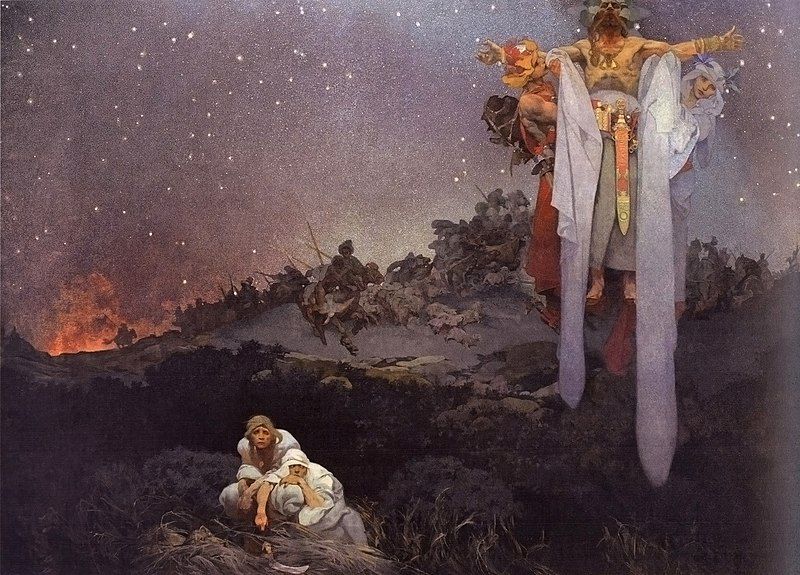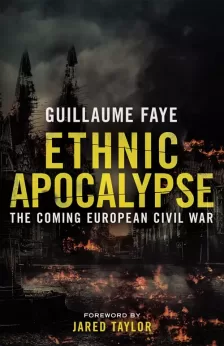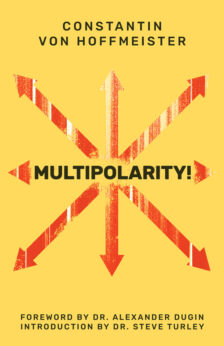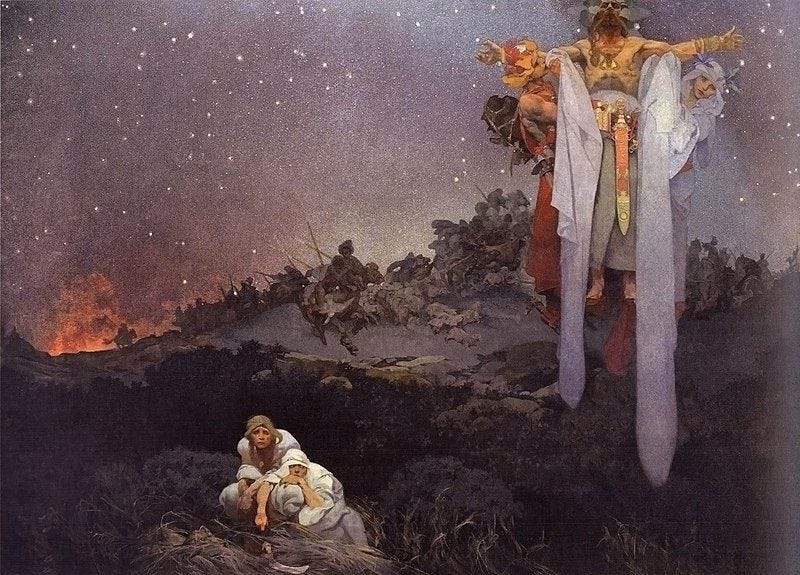
Alphonse Mucha, ‘Slavs in their Original Homeland: Between the Turanian Whip and the Sword of the Goths’
Following biology, mineralogy is probably the second most influential discipline in Spengler’s philosophy of history. From it, the author borrows the notion of pseudomorphosis, a phenomenon where a mineral experiences total replacement by an alien mineral, which eventually leads to a false formation. This often occurs as fissures and clefts appear within strata that lead to water filtering in and washing out the crystal or original mineral, leaving behind only the shape of the respective mineral. Following volcanic eruptions, magma permeates the cracks and eventually crystalizes into new minerals, leading to a false formation, whereby the shape of the original mineral remains but is replaced by an alien mineral. The end result is a distorted form where the internal structure has no organic link with the external form. From this, Spengler coins the term “historical pseudomorphosis” to describe cases where a mature culture overwhelms a younger culture in a hegemonic manner to the extent that the emergent culture struggles to grow and realize its potential, purpose, destiny and soul. The theme of tragedy plays a crucial role within Spengler’s overarching narrative, and there is probably no other concept that best reflects this tragic element within Spengler’s writings than the notion of pseudomorphosis, as we shall now demonstrate. It is also crucial to add that through his conception of pseudomorphosis, Spengler reaffirms his stance as a historian who denies any Eurocentric approach to world-history by adopting a position of cultural relativism. Finally, the beauty of historical pseudomorphosis is that it is an embodiment of the sympathy Spengler possessed for many non-Western cultures once suppressed by the hegemonic chains of an older alien culture clinging to its life through desperation.
Of the many cases of pseudomorphosis that Spengler put forward, and perhaps most relevant to our time, is the case of Russian culture. Within Spengler’s framework, the Russian Orthodox or Slavic culture is destined to metamorphose into a high-culture within the near future. That is to say, it is the only culture around the world that is displaying elements of organic growth that could possibly displace Western culture following its demise, through manifesting its essence, soul and unique architectural, artistic, political, religious and scientific forms. To Spengler, the Russian or Slavic culture is neither European nor Asian but a unique culture and world with a distinct world-view, an original architectural expression which has not yet been expressed, and an inherent prime symbol which is the idea of an endless flat plain, inspired by the vast Eurasian steppes and endless plains. Assuming a continent of Europe, a merely abstract geographic presumption, in historical analysis does not only lead to a flawed picture of world-history, but also dire consequences such as the pseudomorphic effect that had constrained the Russian soul. Spengler stated that “the word ‘Europe’ ought to be struck out of history.” For the Russian soul, the narrow and empty notion of such a word is evident in the concept of “Mother Russia,” separating it from the “fatherlands” of the Western people. The weakness of these geographic constructs as opposed to higher cultures as historical units of analysis becomes even more apparent when comprehending the similar tendencies the Russian shares with the Tartar and Turk. A point of view Spengler shared with Leontiev, who also possessed a similar argument, adding that a Russian possesses traits that remind us of “Turks, Tartars, and other Asians than of the southern and western Slavs.” This unique emphasis on culture when exploring the depth of the Russian soul is expressed further when Leontiev argued:
In this sense precisely, I may allow myself to state a strange thing about Russia, namely, that she is, of all the Slavs, both the least Slavic and, at the same time, the most Slavic nation. She is the least Slavic nation because, by her history, by her composition, by her psychic and mental structure, she is very distinct from all the other Slavs. On the other hand, Russia is the most Slavic of all not only because she is called upon to be the head of the Slavs politically but also because she already has and is engendering that which, affirming itself, can develop further — those many elements which, until the present, were not peculiar to either Europeans or Asians, either to the West or to the East. This is natural enough, for only out of a more Oriental or, so to speak, a more Asiatic–Turanian nation, in the midst of the Slavic nations, can emerge something spiritually independent of Europe.
Thus, the real Europe, Spengler affirmed, “ends at the Vistula,” and beyond that lies the Slavic or Russian world that could only be understood through reviewing the West’s past as a high culture. Designating cultures as units of historical analysis means that in order to comprehend Russia’s history between 900 and 2000 AD, we would have to compare it to the similar stages of development within the history of Western civilization, that is, the pre-cultural and summer phases of Faustian Western culture, approximately from “the Age of Rome to Charlemagne and the Hohenstaufen emperors.” Through adopting Goethe’s methodology, Spengler’s morphology of history allows us to trace the similar stages of development each culture, whilst revealing the different feelings and ideas emanating from every culture, reflected in their distinct political, artistic, and religious expressions. In the case of Russia, the endless plains “created a softer form of humanity, humble and morose, inclined to lose itself mentally in the flat expanses of its homeland, lacking genuine personal will, and prone to servility.” On the politico-historical plane, this led to the manifestation of a new form of politics and leaders of “world-historical” significance in Russia, from Genghis Khan, to Ivan the Terrible, to Peter the Great, and Lenin. The expansiveness of Russia is yet another reflection of the Russian soul, the idea of an endless flat plain, and is a result of Russia’s semi-nomadic origins. According to Spengler, even the agrarian communes employed by Tsarist governments were not able to stop the “inborn wanderlust” of Russian peoples and bind them to the soil and constrict their emotional yearning for the “limits of the infinite.” Thus, the movement of waves of Russians towards the new expanses in the Caucasus, steppes of Russia, and Russian Turkestan were nothing but a reflection of this curious semi-nomadic spirit, in the words of Spengler:
The result of this inner restlessness has been the extension of the Empire up to the natural borders, the seas and the high mountain ranges. In the sixteenth century Siberia was occupied and settled as far as Lake Baikal, in the seventeenth century up to the Pacific.
The event that triggered this specific pseudomorphosis was the construction of St. Petersburg by Tsar Peter the Great, which paved the way for the imprisonment of the Russian soul and the imposition of an alien form. Situated outside of the European world, St. Petersburg ironically represented everything European and was culturally detached from Russia. Fixated on the West and Europe, Tsar Peter was indifferent about the Pacific coast and had his eyes on the Baltic coast, which he viewed as a bridge to Europe. Although Peter the Great possessed the socio-political, military and economic power to resist this effect, as did Charlemagne and Charles Martel when resisting the Islamic-Byzantine invasion of their own respective cultures, he chose to surrender the fate of Russia. If the Magian-Islamic Arabian culture was deprived of its youth and maturity due to Greco-Roman hegemony, the Faustian West desired cultural suicide through selling its soul to technology and modernity in its obsessive quest for infinite progress. The Russian Slavic culture tragically, and willingly, enslaved itself to Western culture, a tragedy that Spengler accurately depicts when he wrote:
The burning of Moscow, that mighty symbolic act of a primitive people, the expression of a Maccabean hatred of the foreigner and heretic, was followed by the entry of Alexander I into Paris, the Holly Alliance, and the concert of the Great Powers of the West. And thus a nationality whose destiny should have been to live without a history for some generations still was forced into a false and artificial history that the soul of Old Russia was simply incapable of understanding. Late-period arts and sciences, enlightenment, social ethics, the materialism of world-cities, were introduced, although in this pre-cultural time religion was the only language in which man understood himself and the world. In the townless land with its primitive peasantry, cities of alien type fixed themselves like ulcers — false, unnatural, unconvincing.
This sentiment Spengler shared with Dostoevsky, Aksakov, Danilevsky and many notable 19th-century Russian philosophers and Slavophiles, all of whom viewed St. Petersburg with contempt. Although born in Petersburg, Dostoevsky viewed it as “the most abstract and artificial city in the world.” Through this pseudomorphosis, and comparable to the Arabian culture’s case with Hellenism, the Russian culture grew a hatred for anything European — everything that Europe stood for was now antithetical to the Russian soul. The new Russian loathing of Europe was reminiscent of the Magian-Islamic culture’s hatred towards the pagan and devilish Babylonia and Egypt. To illustrate this idea further, Spengler presents a correspondence between Aksakov and Dostoevsky, whereby they conclude that the “emancipation of the Russian soul” could only occur if all of Russian culture directed its hate towards Petersburg. If Moscow symbolized that which was holy within Russia, its polar opposite, St. Petersburg, was “Satanic” — Tsar Peter was to be depicted as the Antichrist.
Exploring world-history through a Spenglerian lens puts a huge emphasis on the interactivity between different cultures by focusing on the deep contrasts in their world views and the reaction of specific cultures when threatened by a neighboring culture. For instance, when exploring the case of Russia, Spengler continuously refers to the pseudomorphosis of the Magian-Islamic culture in order to shed further light on the unique essence of each distinct culture. The disparity between the Russian culture and Western one is constantly compared to the contrast between Judeo-Christian-Islamic tendencies and the Late-Classical nihilism. The former is “a surfeited disgust of one’s own proper overgrowths,” whilst the latter is a “hatred of the alien that is poisoning the unborn Culture in the womb of the land.” In his analysis of Russian Orthodox culture, Spengler describes the deep spiritual contrasts between a young culture and an older petrified civilization: the former exhibits “depths of religious feeling, flashes of revelation, shuddering fear of the great awakening, metaphysical dreaming and yearning” spiritual tendencies that are common to beginning of history, meanwhile the “pain of spiritual clarity belongs to the end of a history.” The tragedy of pseudomorphosis is the intermingling of these two tendencies, which a primitive culture and people fail to comprehend — leading to a distortion of its forms. Spengler illustrates this phenomenon by borrowing a notion from Dostoevsky’s writings, “Everyone in the street and market-place now speculates about the nature of Faith.” In Spengler’s writings concerning Russian culture, Dostoevsky’s works embody the collective unconscious of the Russian people. This is evident within the Russian novelist’s “Pushkin Speech,” where he negates the “false Russian man” and says:
He is a man who is restless and will never content himself with the existing order, who does not believe in his native soil or its powers, who ultimately negates Russia and himself, who does not want to share anything in common with his fellow compatriots, and who nevertheless sincerely suffers from all this.
Spengler uncovers in Dostoevsky the suffering of a nation that yearns for a return to their open land and a detestation for the soulless, godless and inorganic monstrous megalopolis that the Antichrist tries to lure them into. If Dostoevsky was the mouthpiece of the Russian peasantry, Tolstoy came to embody the Western-styled upper classes of Russia. The contrast between Tolstoy and Dostoevsky, who Spengler calls “the two spokesmen and victims of the pseudomorphosis,” is a reflection of the disparity between the upper class and peasantry within Russia. Dostoevsky “could never in his soul get away from the land,” whilst Tolstoy “in spite of his desperate efforts, could never get near it.” Tolstoy is the embodiment of the former Russia, tied to the West, a transitioning point between Petrinism and Bolshevism. To Spengler, Tolstoy is the father of Bolshevism, albeit unknowingly. Although he attempts to deny Petrinism and the West, he could never detach his soul from them. Dostoevsky, on the other hand, is the future Russia, beyond Petrinism and Bolshevism. His works are apocalyptic, and this is evident within the dialogue of his characters that essentially give us a glimpse of the future of Russia and the West. Whilst Tolstoy is viewed as a Western-styled revolutionary, Dostoevsky is a Russian saint or prophet. If he were to complete his work on the life of Christ, it would have been equivalent to the early Christian Bible to Russia. Bolshevism to Spengler was nothing but a revolt of the lowest stratum of Petrine society against their own authorities, a Western unrecognized product of Petrinism. Spengler concludes ambitiously and passionately, writing, “Tolstoi’s Christianity was a misunderstanding. He spoke of Christ and he meant Marx. But to Dostoyevski’s Christianity the next thousand years will belong.” Thus, as Russia began slowly shedding the pseudomorphic effect, Petrinism and Bolshevism both vanished as Spengler predicted:
The peasantry is the true Russian people of the future; it will not allow itself to be perverted and suffocated, and without a doubt, no matter how slowly, it will replace, transform, control, or annihilate Bolshevism in its present form. How that will happen, no one can tell at the moment.
Indeed, a century later Russia has replaced Bolshevism from within and taken the course towards a new future further away from the West and its forms, in search of its original forms. If Russia’s orientation towards the West was a result of Petrinist tendencies and the pseudomorphosis, then what direction is the Russian soul yearning for? Spengler believed that since Russia has begun to forget the West it has “long since begun to look toward Near and East Asia.” Russians, according to Spengler, are “not a maritime people.” This is also a reflection of the type of civilization Russia is, an inland civilization that expands through land rather than sea and is less dependent on coastlines, as reflected in Alexander Dugin’s concept of tellurocracies and its relation to Eurasianism as opposed to the West’s maritime thalassocracy and Atlanticism. Perhaps the greatest expression of this inland-penetrating urge and Russia’s innate hatred for the self-imposed Bolshevism and Western modernity is seen in the adventures of Roman von Ungern-Sternberg in the Eastern regions of the Russian empire. Ungern viewed his mission as one which attempted to shield the world of tradition and piety from “the Gogs and Magogs of Bolshevism, democracy, and the profane world, the freaks of the modern world,” and it was destiny that brought him to the East, “the Rising Sun,” to fulfill this sacred mission from the decadent reach of modern Western civilization. Seen as the literal manifestation of the “God of War,” Ungern managed to free Mongolia from Chinese troops with links to the Bolsheviks with an army of Russian Cossacks, Mongols, Tatars and many more Eurasian peoples, in one of the last brave stands during the Russian Civil War. Ungern’s vision was to restore the greater Mongol empire as “Khalka, the magical shield of the earth.” Inspired by the legend of Agartha, his objective was to establish a special order of warrior-monks in order to proclaim a Buddhist geopolitical zone stretching from Mongolia to Tibet, incorporating the steppes of Tartary, Siberia, and eventually Europe:
On the dizzying border of India and China, my empire will be reborn. We will speak Sanskrit and live according to the principles of the Rig Veda. We will gain the law that Europe has lost. And once again the light of the North will shine. The eternal law, dissolved in the waters of the Ganges and Mediterranean, will prevail.
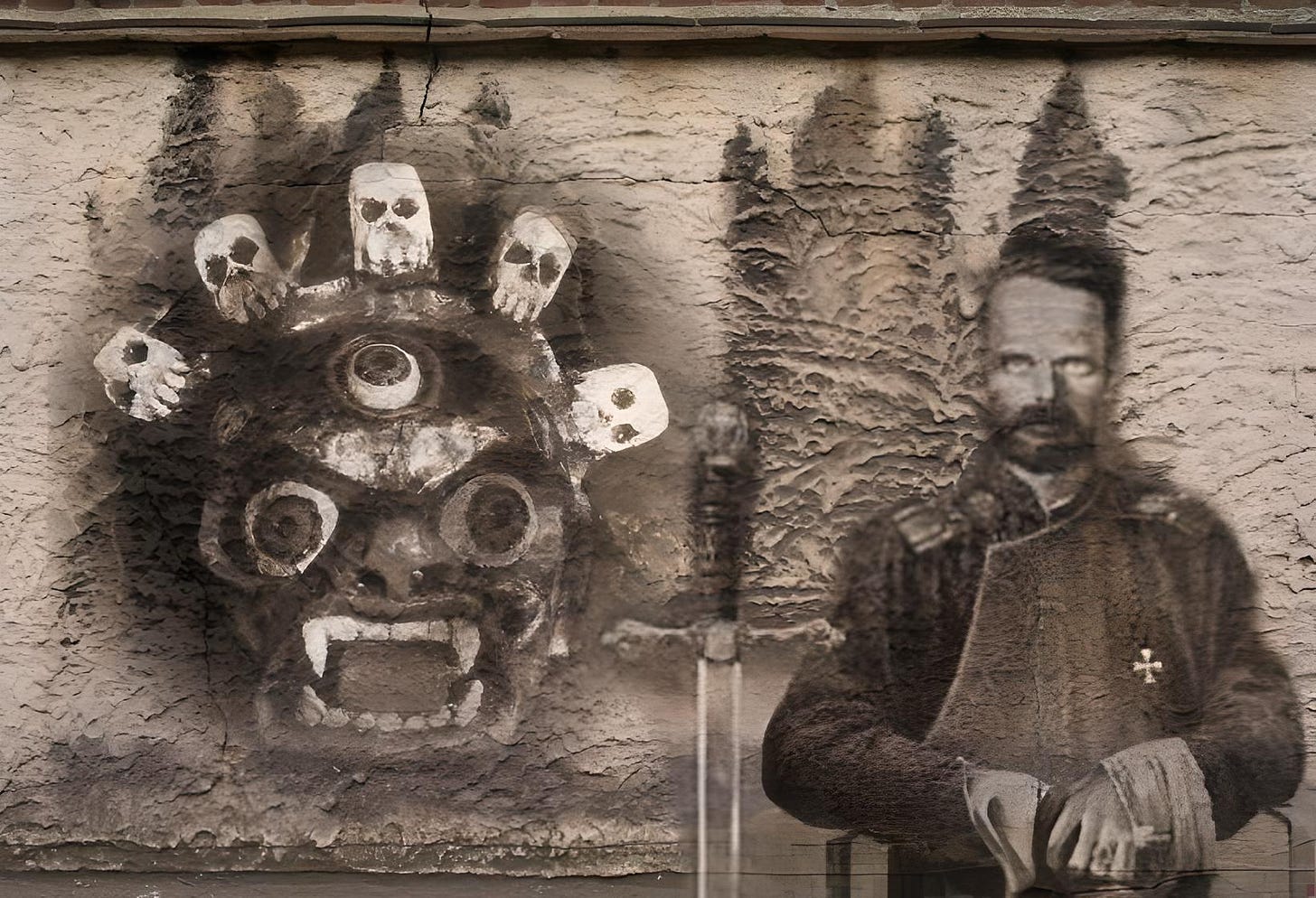
Baron Roman von Ungern-Sternberg
Ungern’s dreams were shattered after being captured and executed by firing squad. The dreams of a Eurasian Shambala died with him. Is the Russian soul then yearning for the East? According to Spengler, that is not necessarily the case, for at a deeper level, this yearning for the East was primarily a reflection of Russia’s recognition of the sovereignty of the East from the rotting West, for the East-West binary “are notions that contain real history.” This trait, the recognition of the sovereignty of other civilizations, is a trait inherent to Russian culture and is echoed in the works of Slavophiles in their sympathetic treatment of other cultures. Yet, the Slavophiles realized the uniqueness of their own world and the distinction between them and other cultures. For although Vladimir Solovyev in Russia and the Universal Church recognized India’s gift to the world through guiding the “universal soul of mankind” towards recognizing the “vanity of material life and conceived an overwhelming disgust for this life of illusion.” He still argued that although India was able to reveal where the absolute was not to be found, it was not able to unveil to the world where the absolute was to be found. The same is to be said about the Greeks and Neoplatonists, for although their idealism leads to a form of positive truth, it is “not the complete and final truth.” As these nations and cultures fulfilled their spiritual contributions to the world, Russia, as a nation materially equipped to play a role in world-history, will contribute its unique ideals and principles for “mankind as a whole.” Concerning this, Solovyev said:
Russia ought to have some clear consciousness of its present tendencies and its future aims. Granted that the fulfilment of our historic mission belongs to the future, yet we must at least have some conception of that future; there must be in Russia of to-day the living seed of its future destinies.
In Leontiev’s musings on India and China, he not only affirmed their civilizational sovereignty as distinct worlds and cultures but, like Solovyev, anticipated Russia’s future historic mission and accurately predicted the re-emergence of China and India as world powers in international politics when he argued that in “the Far East, India and China, as if awakening from their thousand-year-old sleep, claimed their right to participate in universal history.” Spengler, similar to Leontiev, argued that India and China’s civilizational bodies were intact but in stiffened and petrified forms. The once mighty civilizations remain but as stone giants and lack the vitality they once possessed. Leontiev argued further that Russia’s mission, beyond preventing the dominance of a dying modern West, was to restrain “those two reawakened Asiatic worlds” as it stood “between the ferociously state-assertive giant of China and the profoundly mystical monster of India.”
Shall we survive as a state and culture? Or shall we be infected by the Chinese state-system, so indestructible in its spirit, and by the mighty, mystical mood of India? Shall we be able to fuse together this Chinese state system with Indian religiosity and, subjecting European socialism to them…
The uniqueness of Russian culture is apparent in their relativistic treatment of world cultures, confirming their sovereignty and independence through cultural relativism, as opposed to late Western universalistic treatment of other cultures, which complemented the imperialistic tendency of the late stages of Western civilization’s development. This Russian tendency, as reflected in Dostoevsky’s concept of brotherly love in The Brothers Karamazov, has permeated all facets of Russian life and manifested itself in different forms across history and contemporary times. Thus, Russia, as a distinct civilization from the rest, belonging to both East and West yet distinct from other civilizations, transcends and resolves the dialectical clash between East and West and is in itself the synthesis, synthesizing the greatest of the elements of the East and West. Beyond the pseudomorphic Petrinist Russian exploring the late stage Western rationalism and materialism, and the nomadic Russian exploring the magical religiosity of the East, Spengler argued that at a deeper level lies a Russian soul longing for the South that he described as an:
ancient, instinctive, unclear, unconscious, and subliminal drive that is present in the soul of every Russian, no matter how thoroughly westernized his conscious life may be — a mystical yearning for the South, for Constantinople and Jerusalem, a genuine crusading spirit similar to the spirit our Gothic forebears had in their blood but which we hardly can appreciate today.
This mystical yearning for the South is linked to what Dostoevsky argued was Russia’s universal mission, that is, the new unification of mankind, a “brotherly, universal union.” As a messiah amongst civilizations, Russia’s holy aim is a “brotherhood of peoples.” This is in stark contrast to the universalism of the late decaying Faustian modern West that imposed a universal union under the secular enlightenment conception of humanity with their obsession over progress and modernity, rather than respecting each independent civilization’s right to exist. Spengler’s argument concerning Russia’s mystical yearning for Constantinople and Jerusalem cannot be understood without taking into consideration the concept of Russia as “the Third Rome.” Transcending the eternal dialectic conflict as embodied by the East-West dichotomy is the Russian conception of a Third Rome. Solovyev has described it as a “Russian obligation” that is:
to demonstrate that she does not only represent that East, but that she is indeed the Third Rome, not excluding the first Rome, and to reconcile both in herself.
The tragedy of the Russian soul as a result of Western pseudomorphosis is further depicted in the actualization of the idea of a Third Rome during the 20th century as its soul attempted to resolve the East-West binary. Nikolai Berdyaev demonstrated this process in The Russian Idea when he argued that “[i]nstead of the Third Rome in Russia, the Third International was achieved, and many of the features of the Third Rome pass over to the Third International.” The Russian messianic idea of the Third Rome thus manifested in a “distorted form.” As Russia continues to break free from the chains of cultural pseudomorphosis imposed on it by the forces of globalization and modernity, as anti-cultural forces, its vision of a Third Rome has yet to come to fruition. Berdyaev agreed with Spengler when he described Russia as “an apocalyptic revolt against antiquity,” adding further that the extreme difference between the West and Russia is usually overlooked as a result of not understanding the Russian soul. Thus, as Berdyaev argued, there is a “powerful eschatological element in Russian religion” and the Russian people are in essence, in accordance with their metaphysical proclivity, “a people of the End.” Conclusively, the Russian people are the people of the future. In the words of Berdyaev, “they will decide questions which the West has not yet the strength to decide.”
What Spengler called “the two faces of Russia,” Berdyaev associates with the Russian soul’s inclination towards adopting dualistic or binary contradictory principles across its historical development. The instinctive drive of Russia towards Tsargrad — Constantinople — and Jerusalem is juxtaposed against the Russia on the world stage aiming for recognition and treatment as an equal to Europe and the West. Yet, since the original form remained and is felt even when an alien form is superimposed upon it, the “educated, irreligious, Westernized Russians also shared this mystical longing for Jerusalem.” The dualistic nature of the Russian soul, the Russia that is the “great East-West” in the words of Berdyaev, manifests itself in every realm of this culture, Petrinism opposed to Slavophilism, Tsarist as opposed to the Communist, the city intelligentsia up against the countryside peasant. To Spengler, like Berdyaev, these dualistic oppositions almost necessitate one another, even when emerging in a pseudomorphic form. Bolshevism, Spengler argued, although a manifestation of the final stages of Petrinism, had two purposes in Russian history. The first was to destroy the artificial foreign structure, and by doing so it had essentially cleared the way for a new culture to awaken between Europe and East Asia — “it is more a beginning than an end.” Spengler was certain that a new Russian people are in the process of “ becoming”:
Shaken and threatened to the very soul by a frightful destiny, forced to an inner resistance, it will in time become firm and come to bloom. It is passionately religious in a way we Western Europeans have not been, indeed could not have been for centuries. As soon as this religious drive is directed towards a goal, it possesses an immense expansive potential.
The soul of the Russian culture is thus more mysterious than one initially thinks, almost like a matryoshka doll. When one layer is peeled, another deeper layer is found. Beneath the Western-oriented Petrinist is the nomadic Russian pointing East. More deep-seated than the nomad is the crusading Orthodox monk looking south. Yet, at a deeper level, beneath the “mystical tendency” embodied by the outer form of Orthodoxy, “slumbers the unborn new religion of an as yet immature people.” Spengler did not expand this idea further, but Berdyaev gave us clues concerning this specific phenomenon. The prime symbol Spengler designated for Russia is the endless flat plain. This denotes an innate polarity, which Berdyaev believed is due to the Russian soul’s attempt to reconcile the dialectic clash between East and West. To Berdyaev, this polarity is understood in Russia through the concept of “double belief,” which is the combination of Orthodoxy with folk paganism. This illustrates the “inconsistencies to be seen in the Russian people.” Berdyaev argued that this polarity is a result of two contradictory principles, a Dionysian natural elemental paganism and an ascetic monastic Orthodoxy:
The mutually contradictory properties of the Russian people may be set out as thus: despotism, the hypertrophy of the State, and on the other hand anarchism and licence: cruelty, a disposition to violence, and again kindliness, humanity and gentleness: a belief in rites and ceremonies, but also a quest for truth: individualism, a heightened consciousness of personality, together with an impersonal collectivism: nationalism, laudation of self; and universalism, the ideal of the universal man: an eschatological messianic spirit of religion, and a devotion which finds its expression in externals: a search for God, and a militant godlessness: humility and arrogance: slavery and revolt.
The Russian religions can be placed on a spectrum in a sense. On one end there is pure Orthodoxy, the Apollonian principle. On the other end we find a Dionysian paganism, today embodied by the Slavic native faith, Rodnovery. At the center, we have the “Old Believers” as the spiritual intersection, where the inconsistencies of the Russian soul are expressed. As Berdyaev argued, the “religion of the soil is very strong in the Russian people: it lies deep down in the very foundations of the Russian soul. The land is the final intercessor. The fundamental category is motherhood.” The powerful connection with the land thus gives Mat Zemlya, Mother Earth, a “personal incarnation” in the Mother of God. The precedency sometimes given to the Mother of God over the trinity is a reflection of a side in the Russian soul that finds refuge in nature when fearing earthly powers. This is perhaps perfectly embodied today in the alternative communities set up by Old Believers and Rodnover movements in the Russian countryside beyond the anti-cultural and anti-life tendencies of modern cities.
Russophobia is on the rise today, and as a result of the pseudomorphosis and Western universalism during the past centuries, the uniqueness of Russia has been either rejected or demonized. Regardless of the pseudomorphic effects, the Russian Slavic soul continued to materialize through Western forms: in the wide prospekts (avenues) of Russian cities, through the endless pages of the tomes of Russian literature, and even the gigantic Antonov aircraft. Artistically, it has manifested itself in the distinctiveness of Russian architectural forms embodied by Russian cathedrals and churches. It has attempted to pierce through modernism, emerging in Lissitzky’s horizontal skyscrapers and Malevich’s arkhitektons. In cinema, we feel it in the endless single-shot take of Sokurov’s Russian Ark, as the narrator debates the nature of Russian civilization with “the European,” Marquis de Custine, while they traverse the history of the Russian soul across the never-ending halls of the Hermitage Museum. It is also strongly felt in Alphonse Mucha’s massive paintings in the long Slav Epic cycle, depicting the journey of the Slavonic people across the past to the present and projected onto the future in the last painting of the series titled Apotheosis: Slavs for Humanity.
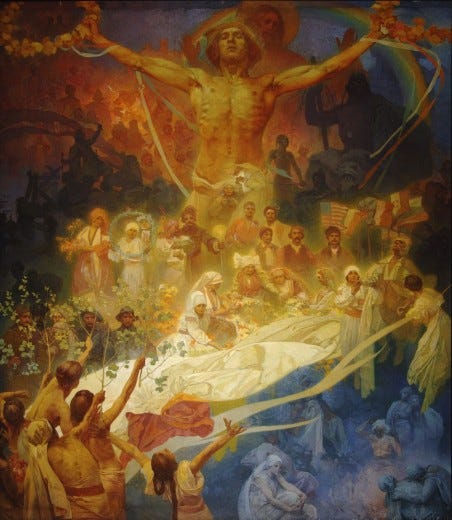
Alphonse Mucha, ‘Apotheosis: Slavs for Humanity’
Spengler’s argument is a reminder that no civilization is immune to the inevitable tides of historical change and that these very tides could result in the elevation of a future new culture. Although arguing that the future belongs to Russia and the Slavic world may seem far-fetched and impossible to many, including Spengler himself when writing his second philosophy of history, one cannot help but wonder how the rising sea levels and the melting of the Arctic, as a result of the ecological crisis, could pave the way for a future Russian culture to rise as a result of a weakening Western civilization. It is important to note the maritime nature of Western civilization and the proximity of hundreds of vital Western cities to the coast. Yet the Russian capital is one of the most inland capitals, and the melting of the Arctic could lead to the establishment of a trans-Arctic trade route, creating new possibilities. More importantly, however, the current geopolitical and economic status of the West is leading to a decline in Atlanticism, which only complements the rise of a Eurasian trade network as one of many global alternatives. That, along with the potential rise of a new multipolar global order replacing the liberal American unipolar global order, illustrates the accuracy of Spengler’s vision of the future. The uniqueness of Russian culture is once again apparent in its relativistic treatment of world cultures, recognizing the sovereignty of all civilizational states — a reflection of Russia’s sentiment of brotherly love at the international level.
Is the current clash between Russia and the West a sign of the Slavic soul freeing itself from Western socio-cultural and political hegemony? That definitely seems to be the case, but whether this will be successful or not depends on the will and strength of the Russian soul. The eschatological dimension of current global developments should not be taken lightly, and, as Alexander Dugin argued, a clash of civilizations in a multipolar world necessitates a clash or alliance of eschatologies. The convergence of eschatologies not only entails a fulfilment of Russia’s world-historical mission but also her eschatological destiny as the Third Rome. With that all being said, a future organic culture will definitely work to heal humanity’s severed connection with nature and the ecological crisis as a result of modernity, and will be characterized by a naive piety and a return to the spirit of the country as opposed to the intellect of the world cities. Although many argue that a planetary culture is what lies beyond the West, I argue that if the Slavic culture is able to free itself from the chains of Western pseudomorphosis, its objective is not only to restore harmony with nature but also to ensure the peaceful coexistence of all world cultures from a global perspective.
